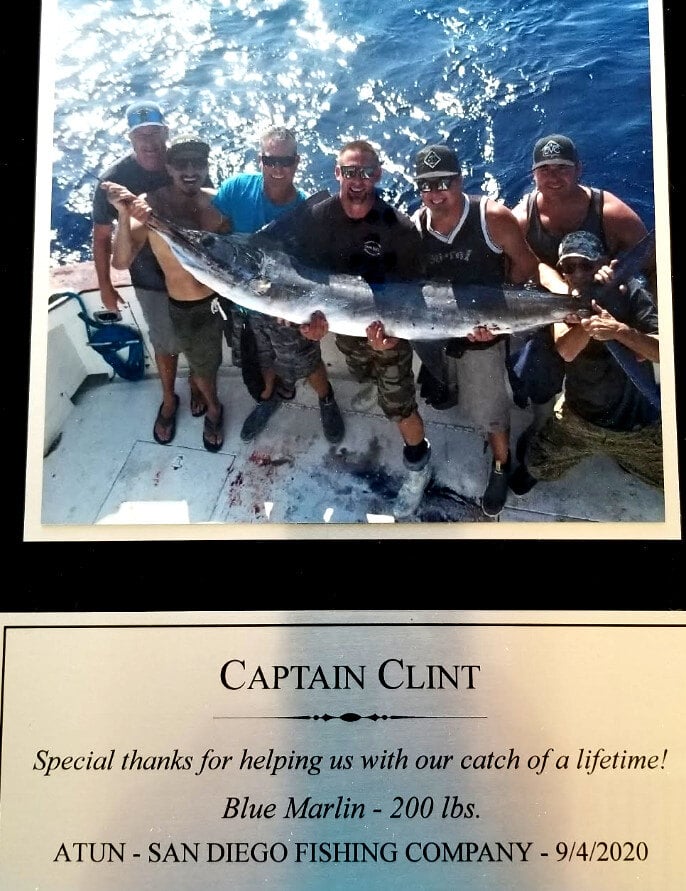Marlin Fishing in San Diego!
Hooking a marlin while fishing off the coast of San Diego or Mexico is a once-in-a-lifetime experience that can leave even the most seasoned anglers in awe. Marlin are renowned for their exceptional speed, strength, and endurance, making them one of the most formidable opponents in the ocean. The Striped Marlin, in particular, is a speed demon, capable of reaching speeds of up to 50 miles per hour, earning it a spot among the top three fastest fish in the world.
When a Blue Marlin bites, be prepared for a fight like no other. These fish are capable of generating immense speed and power, and can quickly deplete even the strongest fishing lines. It's not uncommon for anglers to be surprised by the sheer speed and strength of a Blue Marlin, as it can rapidly take out hundreds of feet of line in a matter of seconds.
Once you've managed to wear the fish down and bring it to the surface, be prepared for an acrobatic display of strength and agility. Marlin are known for their aerial antics, using their powerful tails to launch themselves out of the water in an attempt to shake the hook. As the fish breaks the surface, it will violently shake its head, making it a thrilling and unpredictable experience for even the most experienced anglers.
The battle with a marlin is a test of endurance, strength, and strategy, pushing both the angler and the fish to their limits. It's a fight that requires skill, patience, and a healthy dose of luck, but the reward is well worth the effort. Landing a marlin is a once-in-a-lifetime experience that will leave you with unforgettable memories and a newfound respect for these incredible creatures.

Lures, Live Bait, and Tackle, a quick discussion.
At our fishing operation, we employ two primary methods for targeting marlin: fishing with artificial lures and using live bait. Each approach has its advantages and requires a deep understanding of marlin behavior and habitat.
Fishing for Marlin with Artificial Lures
When fishing with artificial lures, we typically travel long distances at speeds of around 12 knots, covering a lot of ground in search of our quarry. We use large, heavy, fast-running lures that can be seen from a distance, increasing the chances of visually spotting or sonar-marking a marlin. Once we've located a fish, we carefully guide our lure to its position, hoping to entice a strike. While some anglers may debate the effectiveness of this tactic, we've found it to be a productive approach in many cases.
Fishing for Marlin with Live Bait
Live bait fishing is a highly effective method for targeting marlin, particularly when fishing in areas where fish congregate, such as underwater ridges, banks, and shelves. To maximize success, it's essential to use high-quality live bait and to be within visual range of the fish. When casting live bait, accuracy is crucial, as marlin have exceptional vision and can spot the bait from a distance. If you can place the bait within striking distance, the marlin will often make a beeline for it, allowing you to witness the excitement of the strike.
The Importance of Quality Tackle
To increase your chances of landing a marlin, it's essential to use the best quality tackle available. Our vessels are equipped with top-of-the-line, well-maintained gear that's specifically designed for marlin fishing. This includes new line, new drag systems, correct rigging, and high-quality lures. Our experienced crew is also on hand to provide expert guidance and instruction on how to use the gear effectively, ensuring that you have the best possible chance of landing your marlin.
Blue Marlin & Black Marlin
Blue Marlin
The Blue Marlin (Makaira mazara) is one of the largest and most iconic species of marlin found in San Diego waters. Reaching lengths of up to 14 feet and weighing up to 2,000 pounds, Blue Marlin are a prized catch for any angler. These fish are characterized by their vibrant blue color, with a silvery sheen and a distinctive dorsal fin that runs along their back. Blue Marlin are found in tropical and subtropical waters around the world, including the eastern Pacific Ocean, where San Diego is located. However, they are not as common in local waters as other species of marlin. Blue Marlin are a pelagic species, meaning they spend most of their time in the open ocean, and are often found near ocean ridges, seamounts, and other underwater features.
Black Marlin
The Black Marlin (Istiompax indica) is another large species of marlin found in San Diego waters. Reaching lengths of up to 15 feet and weighing up to 1,500 pounds, Black Marlin are a formidable opponent for any angler. These fish are characterized by their dark blue or black color, with a distinctive dorsal fin and a pointed bill. Black Marlin are found in tropical and subtropical waters around the world, including the eastern Pacific Ocean, where San Diego is located. They are more common in local waters than Blue Marlin, and can be found in the coastal waters off of San Diego.
